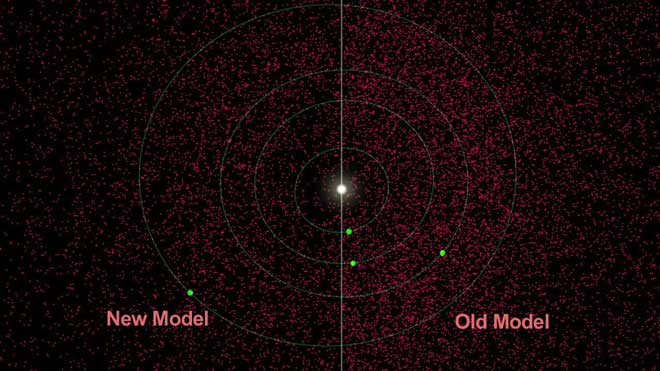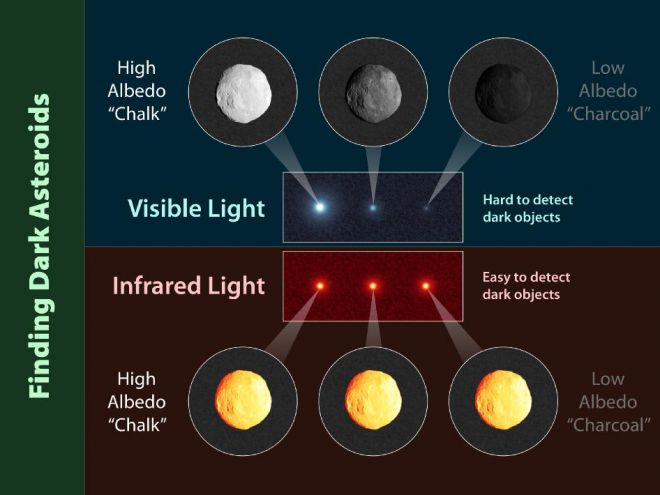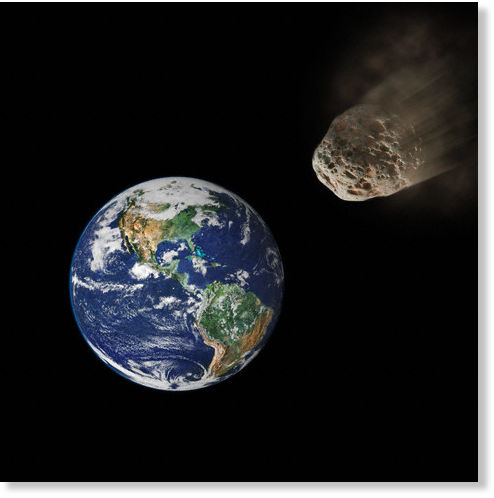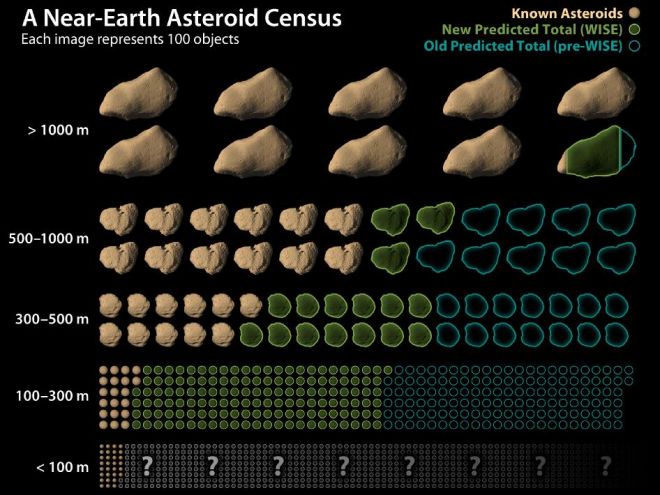Discovered on December 28, 2005 by Robert McMillan of the Spacewatch Program near Tucson, Arizona, 2005 YU55 is believed to be a very dark, nearly spherical object.
According to NASA's Near Earth Object Program: "Although classified as a potentially hazardous object, 2005 YU55 poses no threat of an Earth collision over at least the next 100 years. However, this will be the closest approach to date by an object this large that we know about in advance and an event of this type will not happen again until 2028 when asteroid (153814) 2001 WN5 will pass to within 0.6 lunar distances."
Click here to watch the trajectory of Asteroid 2005 YU55 - November 8-9, 2011.
While neither the European Space Agency (ESA) nor NASA has suggested that YU55 poses a threat to Earth, plans to develop a mission to counteract a potential asteroid collision in the future are already underway.
The ESA is planning to fire an 'impactor' satellite into a 'test' asteroid in 2015 to see if the object's trajectory can be altered. The Agency is conducting the test mission in light of the minimal threat posed by the 700-1100-foot-wide 99942 Apophis asteroid, which has a one in 250,000 chance of impacting Earth in 2036.
Other Recent Asteroid Encounters
In late June 2011, earth experienced one of its closest encounters with an asteroid in recent years. But as NASA indicated in the days ahead of the 'cosmic close call', the encounter was so close that Earth's gravity sharply altered the asteroid's trajectory and prevented the space rock from impacting the planet.
2011MD, a newly discovered asteroid passed within 12,000 kilometres (7,500 miles) of Earth. The asteroid was only sighted for the first time on 22 June by a robotic telescope in New Mexico, USA. The International Astronomical Union's Minor Planet Center in Massachusetts, USA, put out an alert Thursday.
It was daylight in the UK and Ireland (12.30 GMT) when the asteroid passed over the southern Atlantic Ocean, near the coast of Antarctica. The event was observable from South Africa and parts of Antarctica. It also was visible in the hours leading up to the closest approach across Australia, New Zealand, southern and eastern Asia, and the western Pacific.
Some media outlets proclaimed the asteroid to be as big as New York's Empire State Building'. In fact, 2011 MD measured about 16 feet to 35 feet.
According to Minor Planet Center's ranking charts 2011 MD's trip was the fifth-closest recorded Asteroid event. The last asteroid to impact earth was '2008 TC3' which was detected on 7 October 2008, just 19 hours before it burned up in the atmosphere over northern Sudan.
On 2 June, a 10-metre wide asteroid passed between the earth and moon.
Asteroid 2009 BD, which was first observed on 16 January 2009 passed approximately within 0.9 lunar distances (the distance between Earth and the Moon) of earth. Astronomers believe the rock is a rare "co-orbital asteroid" which follows the orbit of the Earth, not receding more than 0.1 AU (15 million km) away.
Two asteroids, several meters in diameter and in unrelated orbits, passed within the moon's distance of Earth on September 8 2010. In April 2010 an asteroid roughly as long as a tennis court zoomed past Earth at about the distance of the moon. The space rock to pass at or within lunar distance previous to this was 2009 JL2, an asteroid about 17 to 37 metres across, in May 2009.
There is a roughly 50 percent chance of a 30-metre-wide plus asteroid striking Earth each century, according to Clark Chapman, a space scientist at the Southwest Research Institute in Boulder, Colorado, USA.
NASA Asteroid Research
Earlier this week, NASA announced it has discovered more than 90 percent of the largest near-Earth asteroids, meeting a goal agreed to with the United States Congress in 1998. The Agency also believes that all near-Earth asteroids approximately 6 miles (10 kilometres) across, as big as the one thought to have wiped out the dinosaurs, have been found.
New observations by NASA's Wide-field Infrared Survey Explorer, or WISE, indicate have allowed astronomers now estimate there are roughly 19,500 - not 35,000 - mid-size near-Earth asteroids. Scientists say this improved understanding of the population may indicate the hazard to Earth could be somewhat less than previously thought.
However, the majority of these mid-size asteroids remain to be discovered. More research also is needed to determine if fewer mid-size objects (between 330 and 3,300-feet wide) also mean fewer potentially hazardous asteroids, those that come closest to Earth.
The results come from the most accurate census to date of near-Earth asteroids, the space rocks that orbit within 120 million miles (195 million kilometres) of the sun into Earth's orbital vicinity.
WISE scanned the entire celestial sky twice in infrared light between January 2010 and February 2011, continuously snapping pictures of everything from distant galaxies to near-Earth asteroids and comets. NEOWISE observed more than 100 thousand asteroids in the main belt between Mars and Jupiter, in addition to at least 585 near Earth.


"The risk of a really large asteroid impacting the Earth before we could find and warn of it has been substantially reduced," said Tim Spahr, the director of the Minor Planet Center at the Harvard Smithsonian Center for Astrophysics in Cambridge, Mass.
The situation is different for the mid-size asteroids, which could destroy a metropolitan area if they were to impact in the wrong place. The NEOWISE results find a larger decline in the estimated population for these bodies than what was observed for the largest asteroids. So far, the Spaceguard effort has found and is tracking more than 5,200 near-Earth asteroids 330 feet or larger, leaving more than an estimated 15,000 still to discover. In addition, scientists estimate there are more than a million unknown smaller near-Earth asteroids that could cause damage if they were to impact Earth.
This chart shows how data from NASA's Wide-field Infrared Survey Explorer, or WISE, has led to revisions in the estimated population of near-Earth asteroids. The infrared-sensing telescope performed the most accurate survey to date of a slice of this population as part of project called NEOWISE. This allowed the science team to make new estimates of the total numbers of the objects in different size categories. NEOWISE observed more than 500 objects larger than 100-meters (330-feet) wide - what can be thought of as medium to large-size asteroids. Near-Earth asteroids smaller than this size range were not studied, and near-Earth comets will be analyzed at a later time. Asteroid sizes are not drawn to scale in the chart.
Each asteroid image represents about 100 actual objects. Near-Earth asteroids that have already been found are filled in and appear brown. An entire row of asteroid images through the blue outlines shows how many total objects were thought to exist before the NEOWISE survey. The green outlines show the reduced new estimates based on the NEOWISE data.
As the graphic reveals, only a small difference was observed in the estimated total numbers of the largest asteroids - the ones with the potential for global consequences should they impact Earth. For the medium-sized asteroids, which could still destroy a metropolitan area, new estimates predict fewer space rocks than previously thought. Details are listed below.
- For the largest asteroids, larger than 1,000 meters (3,300 feet), NEOWISE data revises the total population down to 981 from a prior estimate of about 1,000. While this is not a dramatic difference, the findings show that NASA has met an initial near-Earth asteroid goal agreed to with Congress in 1998, calling for at least 90 percent of the largest objects to be found. There are an estimated 911 objects of this size range known, which means that NASA has found 93 percent. That leaves roughly 70 of these bodies left to find.
- The NEOWISE data reveals an approximately 44 percent decline in the estimated numbers of medium-sized asteroids, which are defined as those objects between 100 meters and 1,000 meters (330 and 3,300 feet). Estimates now indicate about 19,500, where as 35,000 were thought to exist before.
- The study does not apply to objects smaller than 100 meters (330 feet), but it is estimated that there are more than a million in this size range based on previous studies.





with the earth at 4000 miles radius, and the lunar distance 240,000 miles - which is 60x greater - it should be pretty easy to do a basic calculation and approximate that one in every 3600 (or 60^2) asteroids that comes withing a lunar distance will hit earth
just find out the number and size of asteroids that come within a LD each year, and you the BASIC strike rate. (denser areas or cyclical events not included)